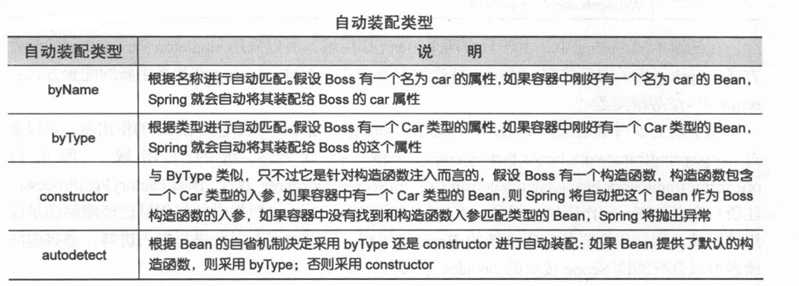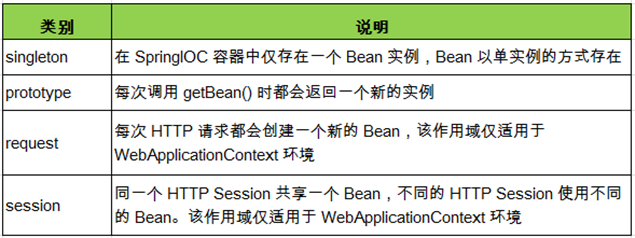在Spring配置文件中,用户不但可以将String、int等字面值注入Bean中,还可以将集合、Map等类型注入Bean中,此外还可以注入配置文件中其他定义的Bean。
一、字面值
(1)可用字符串表示的值,可以通过<value>元素标签或value属性进行注入。
(2)基本数据类型及其封装类、Stting类型都可以采用字面值注入的方式。
(3)若字面值包含特殊字符,可以使用<![CDATA[]]>把字面值包裹起来。
<bean id="car" class="com.kiwi.domain.Car"> <property name="brand" > <value><![CDATA[BMW&x5]]></value> </property> <property name="color" value="Black"/> <property name="price" value="800000"/> <property name="maxSpeed" value="200"/> </bean>
由于brand属性包含了一个XML的特殊符号,因此特意在属性值外添加一个XML特殊处理标签<![CDATA[]]>,这个标签的作用就是让XML解析器将标签中的字符串当作普通文本对待,以防止某些字符对XML格式造成破坏。
二、引用其他Bean
(1)要使Bean能相互访问,就必须在Bean的配置文件中指定对Bean的引用。
(2)在Bean的配置文件中,可以通过<ref>属性或元素配置。
(3)也可以在属性内部包含Bean的声明,这样的Bean称为内部Bean。
(4)内部Bean不能被外部使用。
Person.java
public class Person{
private String name;
private int age;
private Car car;
@Override
public String toString(){
return "Person [name=" + name + ", age=" + age + ", car=" + car + "]";
}
//省略get set...
}
applicationContext.xml
<?xml version="1.0" encoding="UTF-8"?> <beans xmlns="http://www.springframework.org/schema/beans" xmlns:xsi="http://www.w3.org/2001/XMLSchema-instance" xsi:schemaLocation="http://www.springframework.org/schema/beans http://www.springframework.org/schema/beans/spring-beans.xsd"> <bean id="car" class="com.kiwi.domain.Car"> <property name="brand" value="BMW"/> <property name="color" value="Black"/> <property name="price" value="800000"/> <property name="maxSpeed" value="200"/> </bean> <bean id="person" class="com.kiwi.domain.Person"> <property name="name" value="Tom"/> <property name="age" value="26"/> <!-- 使用ref属性建立bean之间的引用关系 --> <property name="car" ref="car"/> </bean> </beans>
Test.java
@Test
public void testCar(){
ApplicationContext context = new ClassPathXmlApplicationContext("applicationContext.xml");
Person person = (Person)context.getBean("person");
System.out.println(person);
}
结果:
Person [name=Tom, age=26, car=Car [brand=BMW, color=Black, price=800000.0, maxSpeed=200]]
如果不引用外部的Bean,可以在内部声明一个内部Bean,这个内部Bean不能被其他外部Bean引用。
<?xml version="1.0" encoding="UTF-8"?> <beans xmlns="http://www.springframework.org/schema/beans" xmlns:xsi="http://www.w3.org/2001/XMLSchema-instance" xsi:schemaLocation="http://www.springframework.org/schema/beans http://www.springframework.org/schema/beans/spring-beans.xsd"> <bean id="car" class="com.kiwi.domain.Car"> <property name="brand" value="BMW" /> <property name="color" value="Black" /> <property name="price" value="800000" /> <property name="maxSpeed" value="200" /> </bean> <bean id="person" class="com.kiwi.domain.Person"> <property name="name" value="Tom" /> <property name="age" value="26" /> <!-- 定义一个内部bean,内部bean外面不能引用 --> <property name="car"> <bean class="com.kiwi.domain.Car"> <property name="brand" value="Audi" /> <property name="color" value="Black" /> <property name="price" value="300000" /> <property name="maxSpeed" value="250" /> </bean> </property> </bean> </beans>
结果:
Person [name=Tom, age=26, car=Car [brand=Audi, color=Black, price=300000.0, maxSpeed=250]]
也可以为级联属性赋值。
<?xml version="1.0" encoding="UTF-8"?> <beans xmlns="http://www.springframework.org/schema/beans" xmlns:xsi="http://www.w3.org/2001/XMLSchema-instance" xsi:schemaLocation="http://www.springframework.org/schema/beans http://www.springframework.org/schema/beans/spring-beans.xsd"> <bean id="car" class="com.kiwi.domain.Car"> <property name="brand" value="BMW" /> <property name="color" value="Black" /> <property name="price" value="800000" /> <property name="maxSpeed" value="200" /> </bean> <bean id="person" class="com.kiwi.domain.Person"> <property name="name" value="Tom" /> <property name="age" value="26" /> <property name="car" ref="car"/> <!-- 为级联属性赋值,前提是属性先初始化然后才可以为其级联属性赋值 --> <property name="car.maxSpeed" value="250"/> </bean> </beans>
结果:
Person [name=Tom, age=26, car=Car [brand=BMW, color=Black, price=800000.0, maxSpeed=250]]
三、集合属性
1.List和Set
(1)配置List需要指定<list>标签,标签里包含一些元素,这些元素可以通过<value>指定简单的常量值,也可以使用<ref>指定对其他Bean的引用。
(2)配置set需要使用<set>标签,其他属性和List一样。
Person.java
public class Person{
private String name;
private int age;
private List<Car> cars;
//省略get set...
}
applicationContext.xml
<?xml version="1.0" encoding="UTF-8"?> <beans xmlns="http://www.springframework.org/schema/beans" xmlns:xsi="http://www.w3.org/2001/XMLSchema-instance" xsi:schemaLocation="http://www.springframework.org/schema/beans http://www.springframework.org/schema/beans/spring-beans.xsd"> <bean id="car" class="com.kiwi.domain.Car"> <property name="brand" value="BMW" /> <property name="color" value="Black" /> <property name="price" value="800000" /> <property name="maxSpeed" value="300" /> </bean> <bean id="car2" class="com.kiwi.domain.Car"> <property name="brand" value="Audi" /> <property name="color" value="Black" /> <property name="price" value="400000" /> <property name="maxSpeed" value="250" /> </bean> <bean id="person" class="com.kiwi.domain.Person"> <property name="name" value="Tom" /> <property name="age" value="26" /> <!-- 配置集合属性List --> <property name="cars"> <list> <ref bean="car"/> <ref bean="car2"/> </list> </property> </bean> </beans>
结果:
Person [name=Tom, age=26, cars=[Car [brand=BMW, color=Black, price=800000.0, maxSpeed=300], Car [brand=Audi, color=Black, price=400000.0, maxSpeed=250]]]
2.Map
(1)通过<map>标签定义,子标签使用<entry>标签。
(2)在<entry>标签里可以使用key、key-ref、value、value-ref属性。
Person.java
public class Person{
private String name;
private int age;
private Map<String,Car> cars;
//省略get set...
}
applicationContext.xml
<?xml version="1.0" encoding="UTF-8"?> <beans xmlns="http://www.springframework.org/schema/beans" xmlns:xsi="http://www.w3.org/2001/XMLSchema-instance" xsi:schemaLocation="http://www.springframework.org/schema/beans http://www.springframework.org/schema/beans/spring-beans.xsd"> <bean id="car" class="com.kiwi.domain.Car"> <property name="brand" value="BMW" /> <property name="color" value="Black" /> <property name="price" value="800000" /> <property name="maxSpeed" value="300" /> </bean> <bean id="car2" class="com.kiwi.domain.Car"> <property name="brand" value="Audi" /> <property name="color" value="Black" /> <property name="price" value="400000" /> <property name="maxSpeed" value="250" /> </bean> <bean id="person" class="com.kiwi.domain.Person"> <property name="name" value="Tom" /> <property name="age" value="26" /> <!-- 配置集合属性Map --> <property name="cars"> <map> <entry key="1" value-ref="car"/> <entry key="2" value-ref="car2"/> </map> </property> </bean> </beans>
结果:
Person [name=Tom, age=26, cars={1=Car [brand=BMW, color=Black, price=800000.0, maxSpeed=300], 2=Car [brand=Audi, color=Black, price=400000.0, maxSpeed=250]}]
3.Properties
Properties类型可以看作Map类型的特例,Map元素的键和值可以是任何类型的对象,而Properties的键和值只能是字符串。
Boss.java
public class Boss{
private Properties mails;
@Override
public String toString(){
return "Boss [mails=" + mails + "]";
}
public Properties getMails(){
return mails;
}
public void setMails(Properties mails){
this.mails = mails;
}
}
applicationContext.xml
<bean name="boss" class="com.kiwi.domain.Boss"> <property name="mails"> <props> <prop key="jobMail">123@126.com</prop> <prop key="lifeMail">789@qq.com</prop> </props> </property> </bean>
结果:
Boss [mails={lifeMail=789@qq.com, jobMail=123@126.com}]
4.配置集合类型的Bean
(1)使用基本集合标签定义集合时,不能将集合作为独立的Bean定义,导致其他Bean无法引用该集合,所以无法在不同Bean直接共享集合。
(2)如果希望配置一个集合类型的Bean,而非一个集合类型的属性,则可以通过util命名空间进行配置。
(3)必须先引用util命名空间才能使用。
<?xml version="1.0" encoding="UTF-8"?> <beans xmlns="http://www.springframework.org/schema/beans" xmlns:xsi="http://www.w3.org/2001/XMLSchema-instance" xmlns:util="http://www.springframework.org/schema/util" xsi:schemaLocation="http://www.springframework.org/schema/beans http://www.springframework.org/schema/beans/spring-beans.xsd http://www.springframework.org/schema/util http://www.springframework.org/schema/util/spring-util.xsd"> <bean id="car" class="com.kiwi.domain.Car"> <property name="brand" value="BMW" /> <property name="color" value="Black" /> <property name="price" value="800000" /> <property name="maxSpeed" value="300" /> </bean> <bean id="car2" class="com.kiwi.domain.Car"> <property name="brand" value="Audi" /> <property name="color" value="Black" /> <property name="price" value="400000" /> <property name="maxSpeed" value="250" /> </bean> <!-- 定义一个公共的Map其他Bean能够直接引用它 --> <util:map id="cars"> <entry key="1" value-ref="car"/> <entry key="2" value-ref="car2"/> </util:map> <bean id="person" class="com.kiwi.domain.Person"> <property name="name" value="Tom" /> <property name="age" value="26" /> <!-- 引用公共的Map --> <property name="cars" ref="cars"/> </bean> </beans>
四、使用p命名空间
为了简化XML文件的配置,越来越多的XML文件采用属性而非子元素配置信息。
applicationContext.xml
<?xml version="1.0" encoding="UTF-8"?> <beans xmlns="http://www.springframework.org/schema/beans" xmlns:xsi="http://www.w3.org/2001/XMLSchema-instance" xmlns:util="http://www.springframework.org/schema/util" xmlns:p="http://www.springframework.org/schema/p" xsi:schemaLocation="http://www.springframework.org/schema/beans http://www.springframework.org/schema/beans/spring-beans.xsd http://www.springframework.org/schema/util http://www.springframework.org/schema/util/spring-util.xsd"> <bean id="car" class="com.kiwi.domain.Car" p:brand="AuDi" p:color="Silver" p:price="500000" p:maxSpeed="3000"/> <bean id="person" class="com.kiwi.domain.Person" p:name="Tom" p:age="27" p:car-ref="car"/> </beans>
这样写省略了<property>的子标签,使配置文件更加简洁。
五、自动装配
<bean>元素提供了一个指定自动装配类型的属性:atuowire。Spring提供了4种自动装配类型。
Person.java
public class Person{
private String name;
private Car car;
private Address address;
//...
}
applicationContext.xml
<?xml version="1.0" encoding="UTF-8"?> <beans xmlns="http://www.springframework.org/schema/beans" xmlns:xsi="http://www.w3.org/2001/XMLSchema-instance" xmlns:util="http://www.springframework.org/schema/util" xmlns:p="http://www.springframework.org/schema/p" xsi:schemaLocation="http://www.springframework.org/schema/beans http://www.springframework.org/schema/beans/spring-beans.xsd http://www.springframework.org/schema/util http://www.springframework.org/schema/util/spring-util.xsd"> <bean id="car" class="com.kiwi.domain.Car" p:brand="LandRover" p:price="1200000" /> <bean id="address" class="com.kiwi.domain.Address" p:province="BJ" p:city="CangPing" /> <!-- 可以使用autowire属性指定自动装配的方式 。 byName: 根据名称自动装配,必须将目标bean的名称和属性名设置的完全相同。 byType: 根据类型自动装配,若IOC容器中有多个与目标 bean类型一致的 bean, 在这种情况下,Spring 将无法判定哪个bean最合适该属性,所以不能执行自动装配。 --> <bean id="person" class="com.kiwi.domain.Person" p:name="Tom" autowire="byName" /> </beans>
结果:
Person [name=Tom, car=Car [brand=LandRover, price=1200000.0], address=Address [province=BJ, city=CangPing]]
一般情况下,在实际的项目中很少使用自动装配功能,因为和自动装配功能所带来的好处比起来,明确清晰的配置文档更有说服力一些。
六、Bean之间的关系
Bean直接存在两种关系: 继承、依赖。
1.继承
(1)Spring允许继承bean的配置,被继承的bean称为父bean。
(2)子bean从父bean继承配置,包括属性配置,也可以覆盖父bean的配置。
(3)若只想把父bean作为模板,可以设置其属性abstract属性为true,这样Spring将不会实例化这个bean。
(4)并不是<bean>所有的属性都会被继承,比如:autowire、abstract。
applicationContext.xml
<bean id="address" class="com.kiwi.domain.Address" p:province="BJ" p:city="CangPingQu" /> <bean id="address2" parent="address" p:city="HaiDianQu" />
结果:
Address [province=BJ, city=CangPingQu]
Address [province=BJ, city=HaiDianQu]
2.依赖
depend-on: 表示一个bean的实例化依靠另一个bean先实例化。如果在一个bean A上定义了depend-on B那么就表示:A 实例化前先实例化 B。这种情况下,A可能根本不需要持有一个B对象。
七、Bean的作用域
(1)在Spring中,可以在<bean>元素的scope属性设置Bean的作用域。
(2)默认情况下,Spring只为每个IOC容器里声明Bean创建唯一的一个实例,整个IOC容器都能共享该实例,该作用域为默认的singleton。
applicationContext.xml
<!-- 使用bean的scope属性来配置bean的作用域 singleton: 默认值。容器初始化时创建bean实例,在整个容器生命周期内只创建这一个bean,单例的。 prototype: 容器初始化时不创建bean的实例,而在每次getBean()时都创建一个实例。 --> <bean id="car" class="com.kiwi.domain.Car" p:brand="LandRover" p:price="1200000" scope="singleton" />
@Test
public void testCar(){
ApplicationContext context = new ClassPathXmlApplicationContext("applicationContext.xml");
Car car = (Car)context.getBean("car");
Car car2 = (Car)context.getBean("car");
System.out.println(car == car2);
}
结果:
true
如果修改为scope="prototype",结果将返回false。

